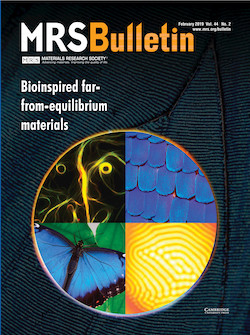Mohan Srinivasarao, Germano S. Iannacchione, and Atul N. Parikh, MRS Bulletin 44, 91-95, 2019
Guest Editorial | Cover

Traditional approaches to materials synthesis have largely relied on uniform, equilibrated phases leading to static “condensed-matter” structures (e.g., monolithic single crystals). Departures from these modes of materials design are pervasive in biology. From the folding of proteins to the reorganization of self-regulating cytoskeletal networks, biological materials reflect a major shift in emphasis from equilibrium thermodynamic regimes to out-of-equilibrium regimes. Here, equilibrium structures, determined by global free-energy minima, are replaced by highly structured dynamical states that are out of equilibrium, calling into question the utility of global thermodynamic energy minimization as a first-principles approach. Thus, the creation of new materials capable of performing life-like functions such as complex and cooperative processes, self-replication, and self-repair, will ultimately rely upon incorporating biological principles of spatiotemporal modes of self-assembly. Elucidating fundamental principles for the design of such out-of-equilibrium dynamic self-assembling materials systems is the focus of this issue of MRS Bulletin.
DOI: 10.1557/mrs.2019.24